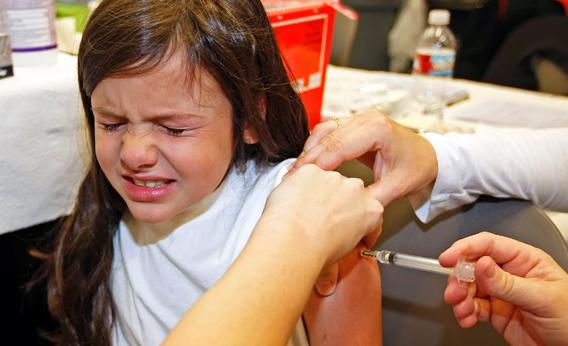 The story of the whooping-cough outbreaks is more complex than just parents who don't vaccinate their kids
The story of the whooping-cough outbreaks is more complex than just parents who don't vaccinate their kidsPhotograph by George Frey/Getty Images.
In the past few years, diseases that vaccines are expected to prevent have flared across the country. Whooping cough killed 10 babies in California in 2010 and the next year measles sickened 21 people in an outbreak in Minnesota. Now this year, measles has struck 14 in Indiana, causing terror along the way with reports that one infected person had visited Super Bowl village. And whooping cough is on track to infect more people in the United States than it has in 50 years.
You can lay much of the blame for the measles outbreaks on the alarming number of parents who don?t vaccinate their kids. Both the Minnesota and Indiana measles episodes were traced to unimmunized people who had picked the disease up abroad and then spread it to others, many of whom were also unvaccinated (or unsure), according to the Centers for Disease Control and Prevention.
But the story of the whooping-cough outbreaks is more complex, with multiple?and unexpected?sources of risk. To be sure, the illness has struck unimmunized children. But the biggest problem is that the current vaccine wears off faster than researchers anticipated. So substantial numbers of vaccinated children are getting the disease. And since adults are supposed to get a booster, and many haven?t, they?re also vulnerable, even if they got all their shots at kids. The vaccine refusers aren?t helping, but the current epidemic is bigger than they are.
In the bad old days, whooping cough, like measles, infected nearly all children, often causing terrible sickness or even death (listen to the characteristic cough, especially harrowing in babies). It was with the advent of a vaccine for whooping cough, created in the 1940s, that the number of deaths plummeted. Known as DPT (it protects against diphtheria and tetanus as well as pertussis, the scientific name for whooping cough) the 1940s formulation also, however, caused serious side effects?perhaps more so than other childhood vaccines. Many kids developed fevers, some high, and a small number had seizures.
The side effects gave rise to legitimate concern?and also to fear mongering. In 1982, a Washington, D.C. TV station broadcast particularly irresponsible ?claims of vaccine-induced brain damage, mental retardation and permanent neurological damage,? as Seth Mnookin relates, and debunks, in his superb book, Vaccine Panic. The anti-vax movement didn?t need to hear more. The infamous vaccine skeptic Barbara Loe Fisher became active in the wake of the broadcast, convinced that DPT had caused her son?s developmental problems.
So under intense pressure, researchers set about making a vaccine with fewer side effects. In the late 1990s, the Food and Drug Administration approved a new formulation, called DTaP, for babies and children. Before this, the vaccine used dead whole cells of pertussis to stimulate kids? immune systems. Now the newer version deployed only a few selected compounds, not cells. The good news is that it hasn?t caused as many side effects. Early clinical trials suggested that this newer, acellular vaccine was also highly effective.
But as Tom Clark, a pertussis expert at the CDC, told me, the studies fell short. They tended not to follow children for a long enough time. Or they defined cases in a way that missed milder infections. As a result, the studies missed a dire fact: The new vaccine doesn?t actually work for as long as the old one.
Source: http://feeds.slate.com/click.phdo?i=4d3a376f6899e90097b60c53fabbfbfe
ben nelson extreme couponing taylor lautner sinead o connor dan marino passing record ipad 2 cases movie times
No comments:
Post a Comment
Note: Only a member of this blog may post a comment.